Three-Dimensional Electromagnetic Imaging of Geothermal System in Gonghe Basin
Abstract
1. Introduction
2. Geological Background
3. Observation and Data Processing
3.1. MT Method and Data Acquisition
3.2. Data Processing
3.3. Dimensional Analysis
3.4. 3D-Magnetotelluric Inversion Results
4. Discussion
4.1. Heat Source Discussion
4.2. Comprehensive Analysis of ZR2 HDR Borehole
4.3. Geothermal Model
5. Conclusions
Author Contributions
Funding
Data Availability Statement
Acknowledgments
Conflicts of Interest
References
- Zhang, C.; Hu, S.B.; Zhang, S.S.; Li, S.T.; Zhang, L.Y.; Kong, Y.L.; Zuo, Y.H.; Song, R.C.; Jiang, G.Z.; Wang, Z.T. Radiogenic heat production variations in the Gonghe basin, northeastern Tibetan Plateau: Implications for the origin of high-temperature geothermal resources. Renew. Energy 2020, 148, 284–297. [Google Scholar] [CrossRef]
- Zhang, C.; Hu, S.B.; Song, R.C.; Zuo, Y.H.; Jiang, G.Z.; Lei, Y.D.; Zhang, S.S.; Wang, Z.T. Genesis of the hot dry rock geothermal resources in the Gonghe basin: Constraints from the radiogenic heat production rate of rocks. Chin. J. Geophys. 2020, 63, 2697–2709. [Google Scholar] [CrossRef]
- Tang, J.Y.; Hu, S.B.; Pang, Z.H.; Pang, Z.H.; He, L.J.; Zhao, P.; Zhu, C.Q.; Rao, S.; Tang, X.Y.; Kong, Y.L.; et al. Estimate of Geothermal Resources Potential for Hot Dry Rock in the continental Area of China. Sci. Technol. Rev. 2012, 30, 25–31. [Google Scholar] [CrossRef]
- Xu, T.F.; Yuan, Y.L.; Jia, X.F.; Lei, Y.D.; Li, S.T.; Feng, B.; Hou, Z.Y.; Jiang, Z.J. Prospects of power generation from an enhanced geothermal system by water circulation through two horizontal well: A case study in the Gonghe Basin, Qinghai Province, China. Energy 2018, 148, 196–207. [Google Scholar] [CrossRef]
- Mao, X.; Guo, D.B.; Luo, L.; Wang, T. The global development process of hot dry rock (enhanced geothermal system) and its geological background. Geol. Rev. 2019, 65, 1462–1472. [Google Scholar] [CrossRef]
- Tester, J.W.; Anderson, B.J.; Batchelor, A.S.; Blackwell, D.D.; Pippo, R.D.; Drake, E.M.; Garnish, J.; Livesay, B.; Moore, M.C.; Nichols, K.; et al. The Future of Geothermal Energy-Impact of Enhanced Geothermal Systems (EGS) on the United States in the 21st Century; MIT Massachusetts Institute of Technology: Cambridge, MA, USA, 2006. [Google Scholar]
- Breede, K.; Dzebisashvili, K.; Liu, X.L.; Gioia, F. A systematic review of enhanced(or engineered)geothermal systems: Past, present and future. Geotherm. Energy 2013, 1, 4. [Google Scholar] [CrossRef]
- Wang, G.L.; Zhang, W.; Lin, W.J.; Liu, Z.M.; Wang, W.L. Evaluation of Geothermal Resources Potential in China. Acta Geosci. Sin. 2017, 38, 449–459. [Google Scholar] [CrossRef]
- Kana, J.D.; Nol, D.Y.; Radandi, D.; Nouck, P.N.; Dadjé, A. A review of geophysical methods for geothermal exploration. Renew. Sustain. Energy Rev. 2015, 44, 87–95. [Google Scholar] [CrossRef]
- Wei, W.B.; Jin, S.; Ye, G.F.; Deng, M.; Tan, H.D.; Unsworth, M.; Jones, A.G.; Book, J.; Li, S.H. Conductivity structure of crust and upper mantle beneath the northern Tibetan Plateau: Results of super wide band magnetotelluric sounding. Chin. J. Geophys. 2006, 49, 1215–1225. [Google Scholar] [CrossRef]
- Erdoğan, E.; Candansayar, M.E. The conductivity structure of the Gediz Graben geothermal area extracted from 2D and 3D magnetotelluric inversion: Synthetic and field data applications. Geothermics 2017, 65, 170–179. [Google Scholar] [CrossRef]
- Peacock, J.R.; Mangan, M.T.; McPhee, D.; Wannamaker, P.E. Three-dimensional electrical resistivity model of the hydrothermal system in Long Valley Caldera, California, from magnetotellurics. Geophys. Res. Lett. 2016, 43, 7953–7962. [Google Scholar] [CrossRef]
- Viacheslav, S.; Olga, K.Z.; Goidina, A.G. A new conceptual model of the Icelandic crust in the Hengill geothermal area based on the indirect electromagnetic geothermometry. J. Volcanol. Geotherm. Res. 2013, 257, 99–112. [Google Scholar] [CrossRef]
- Yuan, Z.C.; Zhong, H.P.; Yan, L.K.; Chen, X.B.; Wang, G.J. Imaging the heat source of the Kangding high-temperature geothermal system on the Xianshuihe fault by magnetotelluric survey. Geothermics 2022, 102, 10286. [Google Scholar] [CrossRef]
- Jiang, G.Z.; Gao, P.; Rao, S.; Zhang, L.Y.; Tang, Y.X.; Huang, F.; Zhao, P.; Pang, Z.H.; He, L.J.; Hu, S.B.; et al. Compilation of heat data in the continental area of China (4th edition). Chin. J. Geophys. 2016, 59, 2892–2910. [Google Scholar] [CrossRef]
- Zhang, C.; Zhang, S.S.; Li, S.T.; Jia, X.F.; Jiang, G.Z.; Gao, P.; Wang, Y.B.; Hu, S.B. Geothermal characteristics of the Qiabuqia geothermal area in the Gonghe basin. Chin. J. Geophys. 2018, 61, 4545–4557. [Google Scholar] [CrossRef]
- Gao, J.; Zhang, H.J.; Zhang, S.Q.; Chen, X.B.; Cheng, Z.P.; Jia, X.F.; Li, S.T.; Fu, L.; Gao, L.; Xin, H.L. Three-dimensional magnetotelluric imaging of the geothermal system beneath the Gonghe Basin, Northeast Tibetan plateau. Geothermics 2018, 76, 15–25. [Google Scholar] [CrossRef]
- Hou, Z.; Xu, T.; Jiang, Z.; Bo, F. Geochemical and isotopic characteristics of geothermal water in the Gonghe Basin of the northeast Tibetan Plateau, China. In Proceedings of the 43rd Workshop on Geothermal Reservoir Engineering Stanford University, Stanford, CA, USA, 12–14 February 2018. [Google Scholar]
- Li, Y.G. Hydrogeochemical Characteristics and Its Origin Analysis of Geothermal Water in the Qia Bu-Qia Area, GongHe Basin, QingHai Province. Master’s Thesis, East China University of Tecnology, Nanchang, China, 2016. [Google Scholar]
- Xu, T.F.; Hu, Z.X.; Li, S.T.; Jiang, Z.J.; Hou, Z.Y.; Li, F.Y.; Liang, X.; Feng, B. Enhanced Geothermal System: International Progresses and Research Status of China. Acta Geol. Sin. 2018, 92, 1936–1947. [Google Scholar] [CrossRef]
- Yue, G.F.; Deng, X.F.; Xing, L.X.; Lin, W.J.; Liu, F.; Liu, Y.G.; Wang, G.L. Numerical simulation of hot dry rock exploitation using enhanced geothermal systems in Gonghe Basin. Sci. Technol. Rev. 2015, 33, 62–67. [Google Scholar] [CrossRef]
- Zhang, S.Q.; Yan, W.D.; Li, D.P.; Jia, X.F.; Zhang, S.S.; Li, S.T.; Fu, L.; Wu, H.D.; Zeng, Z.F.; Li, Z.W.; et al. Characteristics of geothermal geology of the Qiabuqia HDR in Gonghe Basin, Qinghai Province. Geol. China 2018, 45, 1087–1102. [Google Scholar] [CrossRef]
- Zhang, S.S.; Zhang, L.; Tian, C.C.; Cai, J.S.; Tang, B.C. Occurrence geological characteristics and development potential of hot dry rocks in Qinghai Gonghe Basin. J. Geomech. 2019, 25, 501–508. [Google Scholar] [CrossRef]
- Zhao, Z.; Chen, H.J.; Ma, J.Q.; Liang, Z.X. Evaluation and Development of Geothermal Resources in Qiapuqia Region, Gonghe Basin, Qinghai Province. Qinghai Environ. 2009, 19, 81–84. [Google Scholar]
- Tang, X.C.; Wang, G.L.; Ma, Y.; Zhang, D.L.; Liu, Z.; Zhao, X.; Cheng, T.J. Geological model of heat source and accumulation for geothermal anomalies in the Gonghe basin, northeastern Tibetan Plateau. Acta Geol. Sin. 2020, 94, 2052–2065. [Google Scholar] [CrossRef]
- Li, L.G.; Li, B.X. A discussion on the heat source mechanism and geothermal system of Gonghe-Guide basin and mountain geothermal field in Qinghai Province. Geophys. Geochem. Explor. 2017, 41, 29–34. [Google Scholar] [CrossRef]
- Sun, J.; Jin, G.W.; Bai, D.H.; Wang, L.F. Sounding of electrical structure of the crust and upper mantle along the eastern border of Qinghai Tibet Plateau and its tectonic significance. Sci. China (Ser. D) 2003, 46, 243–253. [Google Scholar]
- Sun, Z.X.; Li, B.X.; Wang, Z.L. Exploration of the possibility of hot dry rock occurring in the Qinghai Gonghe Basin. Hydrogeol. Eng. Geol. 2011, 38, 119–124. [Google Scholar]
- Wang, B.; Li, B.X.; Ma, X.H. Prediction of thermal reservoir temperature and depth in the exploration and evaluation of dry hot rocks in Gonghe Guide, Qinghai. Undergr. Water 2015, 37, 28–30. [Google Scholar]
- Yan, W.D. Characteristics of Gonghe Basin hot dry rock and its utilization prospects. Sci. Technol. Rev. 2015, 33, 54–57. [Google Scholar] [CrossRef]
- Shi, B.Y.; Zhang, J.T. Discussion on the Gap of Qin Kuntectonic belt. Manag. Strategy Qinghai Land Resour. 1982, 3, 21–29. [Google Scholar]
- Zhang, G.W.; Guo, A.L.; Yao, A.P. Western Qinling-Songpan continental tectonic node in China’s continental tectonics. Earth Sci. Front. 2004, 11, 23–32. [Google Scholar] [CrossRef]
- Kang, W.H. High-quality hot spring with surface water temperature of 96.6 °C found in Guide, Qinghai. Geotherm. Energy 2016, 1, 17. [Google Scholar]
- Xue, J.Q.; Gan, B.; Li, B.X.; Wang, Z.L. Geological-Geophysical Characteristics of Enhanced Geothermal Systems (Hot Dry Rocks) in Gonghe-Guide Basin. Geophys. Geochem. Explor. 2013, 37, 35–41. [Google Scholar] [CrossRef]
- Gao, C.Y.; Huang, X.G.; Dai, W.Q.; Chen, Z.A. Experimental study on electrical conductivity of pyrolite at high temperature and high pressure. Chin. J. Geophys. 2020, 63, 3409–3419. [Google Scholar] [CrossRef]
- Egbert, G.D.; Kelbert, A. Computational recipes for electromagnetic inverse problems. Geophys. J. Int. 2012, 189, 251–267. [Google Scholar] [CrossRef]
- Chave, A.D.; Jones, A.G. The Magnetotelluric Method: Theory and Practice; Cambridge University Press: Cambridge, UK, 2012. [Google Scholar]
- Egbert, G.D.; Booker, J.R. Robust estimation of geomagnetic transfer functions. Geophys. J. Int. 1986, 87, 173–194. [Google Scholar] [CrossRef]
- Gamble, T.D.; Goubau, W.M.; Clarke, J. Magnetotellurics with a remote magnetic reference. Geophysics 1979, 44, 53–68. [Google Scholar] [CrossRef]
- Chen, X.B.; Zhao, G.Z.; Zhan, Y. A visual integrated windows system for MT data process and interpretation. Oil Geophys. Prospect 2004, 39, 11–16. [Google Scholar]
- Caldwell, T.G.; Bibby, H.M.; Brown, C. The magnetotelluric phase tensor. Geophys. J. 2004, 158, 457–469. [Google Scholar] [CrossRef]
- Kelbert, A.; Meqbel, N.; Egbert, G.D.; Tandon, K. ModEM: A modular system for inversion of electromagnetic geophysical data. Comput. Geosci. 2014, 6, 40–53. [Google Scholar] [CrossRef]
- Hill, G.J.; Bibby, H.M.; Ogawa, Y.; Wallin, E.L.; Heise, W. Structure of the Tongariro Volcanic system: Insights from magnetotelluric imaging. Earth Planet. Sci. Lett. 2015, 432, 115–125. [Google Scholar] [CrossRef]
- Liu, F.; Lang, X.J.; Lu, C.; Lin, W.J.; Tong, J.; Wang, G.L. Thermophysical parameters and 1ithospheric thermal structure in Guide Basin, Northeast Qinghai-Tibet Plateau. Environ. Earth Sci. 2017, 76, 199. [Google Scholar] [CrossRef]
- Yun, X.R.; Chen, X.J.; Cai, Z.H.; He, B.Z.; Zhang, S.S.; Lei, M.; Xiang, H. Preliminary study on magmatic emplacement and crystallization conditions and deep structure of hot dry rock in the northeastern Gonghe basin, Qinghai Province. Acta Petrol. Sin. 2020, 36, 3171–3191. [Google Scholar] [CrossRef]
- Tan, H.B.; Zhang, W.J.; Chen, J.S.; Jiang, S.Y.; Kong, N. Isotopeand geochemical study for geothermal assessment of the Xining basin of the northeastern Tibetan Plateau. Geothermics 2012, 42, 47–55. [Google Scholar] [CrossRef]
- Jia, S.X.; Guo, W.B.; Mooney, W.D.; Wang, F.Y.; Duan, Y.H.; Zhao, J.M.; Lin, J.Y.; Liu, Z. Crustal structure of the middle segment of the Qilian fold belt and the coupling mechanism of its associated basin and range system. Tectonophysics 2019, 770, 128154. [Google Scholar] [CrossRef]
- Gao, J.; Zhang, H.J.; Zhang, H.P.; Zhang, S.Q.; Cheng, Z.P. Three-dimensional magnetotelluric imaging of the SE Gonghe Basin: Implication for the orogenic uplift in the northeastern margin of the Tibetan Plateau. Tectonophysics 2020, 789, 228525. [Google Scholar] [CrossRef]
- Bai, D.H.; Unsworth, M.J.; Meju, M.A.; Ma, X.B.; Teng, J.W.; Kong, X.R.; Sun, Y.; Sun, J.; Wang, L.F.; Jiang, C.S.; et al. Crustal deformation of the eastern Tibetan Plateau revealed by magnetotelluric imaging. Nat. Geosci. 2010, 3, 358–362. [Google Scholar] [CrossRef]
- Zhang, Z.J.; Yuan, X.H.; Chen, Y.; Tian, X.B.; Kind, R.; Li, X.Q.; Teng, J.W. Seismic signature of the collision between the east Tibetan escape flow and the Sichuan Basin. Earth Planet. Sci. Lett. 2010, 292, 254–264. [Google Scholar] [CrossRef]
- Jia, S.X.; Zhang, X.K.; Zhao, J.R.; Wang, P.Y.; Zhang, C.K.; Xu, Z.F.; Pan, J.S.; Liu, Z.; Pan, S.Z.; Sun, G.W. Deep seismic sounding data reveal the crustal structures beneath Zoige basin and its surrounding folded orogenic belts. Sci. China Earth Sci. 2010, 53, 203–212. [Google Scholar] [CrossRef]
- Liu, M.; Mooney, W.D.; Li, S.; Okaya, N.; Detweiler, S. Crustal structure of the northeastern margin of the Tibetan plateau from the Songpan-Ganzi terrane to the Ordos basin. Tectonophysics 2006, 420, 253–266. [Google Scholar] [CrossRef]
- Wang, Q.; Gao, Y.; Shi, Y.T.; Shi, Y.T.; Wu, J. Seismic anisotropy in the uppermost mantle beneath the northeastern margin of Qinghai-Tibet plateau: Evidence from shear wave splitting of SKS, PKS and SKKS. Chin. J. Geophys. 2013, 56, 892–905. (In Chinese) [Google Scholar] [CrossRef]
- Zhang, Z.J.; Klemperer, S.; Bai, Z.M.; Chen, Y.; Teng, J.W. Crustal structure of the Paleozoic Kunlun orogeny from an active-source seismic profile between Moba and Guide in East Tibet, China. Gondwana Res. 2011, 19, 994–1007. [Google Scholar] [CrossRef]
- Zhang, H.S.; Gao, R.; Tian, X.B.; Teng, J.W.; Li, Q.S.; Ye, Z.; Liu, Z.; Si, S.K. Crustal S-wave velocity beneath the northeastern Tibetan plateau inferred from teleseismic P-wave receiver functions. Chin. J. Geophys. 2015, 58, 3982–3992. [Google Scholar] [CrossRef]
- Wang, X.B.; Yu, N.; Gao, S.; Luo, W.; Cai, X.L. Research progress in research on electrical structure of crust and upper mantle beneath the eastern margin of the Tibetan plateau. Chin. J. Geophys. 2017, 60, 2350–2370. [Google Scholar] [CrossRef]
- Xiao, Q.B.; Zhang, J.; Zhao, G.Z.; Wang, J.J. Electrical resistivity Structures northeast of the Eastern Kunlun Fault in the Northeastern Tibet: Tectonic implications. Tectonophysics 2013, 601, 125–138. [Google Scholar] [CrossRef]
- Feldman, I.S. On the nature of conductive layers in the earth’s crust and upper mantle. Geoelectr. Geotherm. Stud. 1976, 1, 721–730. [Google Scholar]
- Feng, Y.M.; Chao, X.D.; Zhang, E.P.; Hu, Y.X.; Pan, X.P.; Yang, J.L.; Jia, Q.Z.; Li, W.M. Structure, Orogenic Process and Dynamics of the West Qinling Orogenic Belt; Xi’an Map Press: Xi’an, China, 2002. [Google Scholar]
- Ma, X.B.; Kong, X.R.; Liu, H.B.; Yan, Y.L. The electrical structure of northeastern Qinghai_Tibet plateau. Chin. J. Geophys. 2005, 48, 689–697. [Google Scholar] [CrossRef]
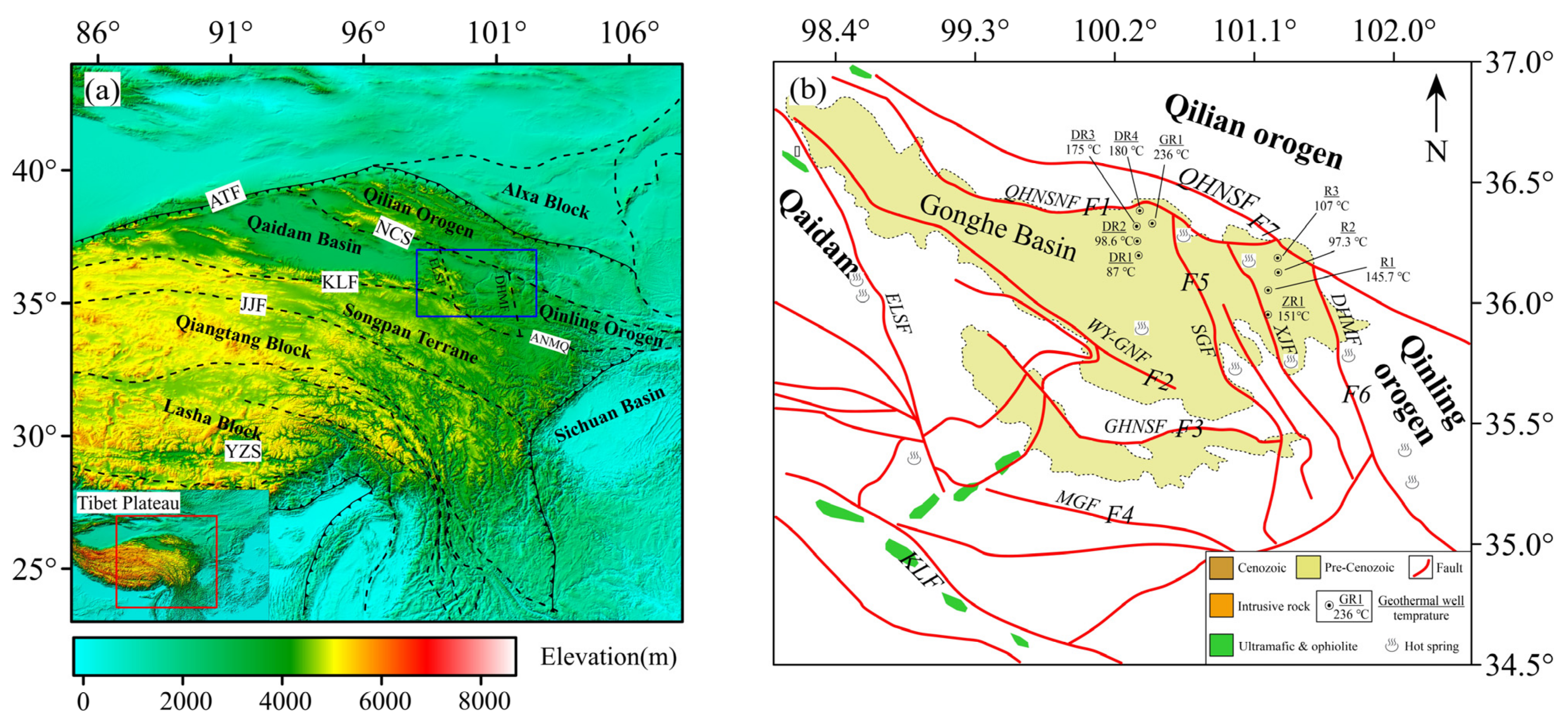
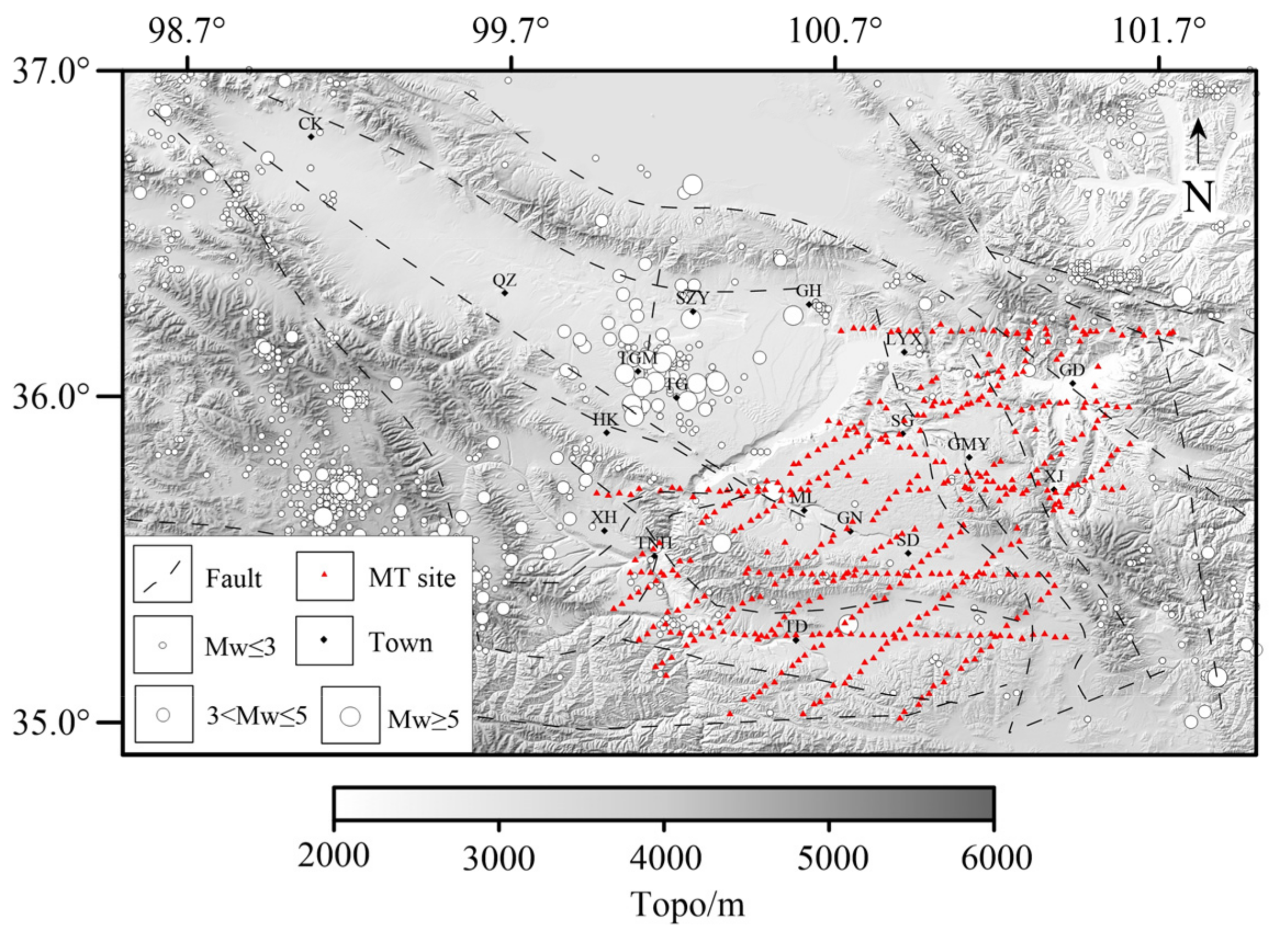
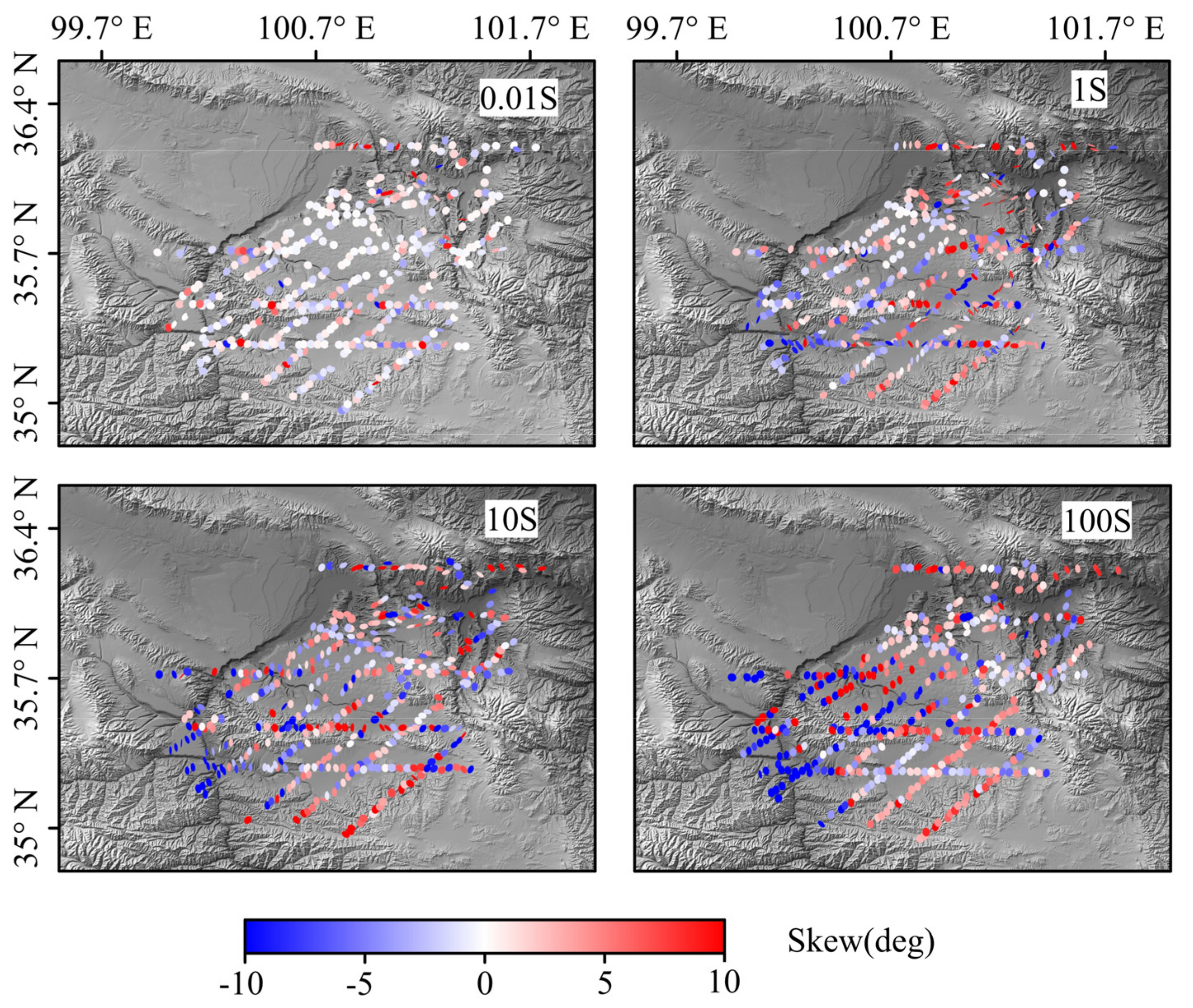
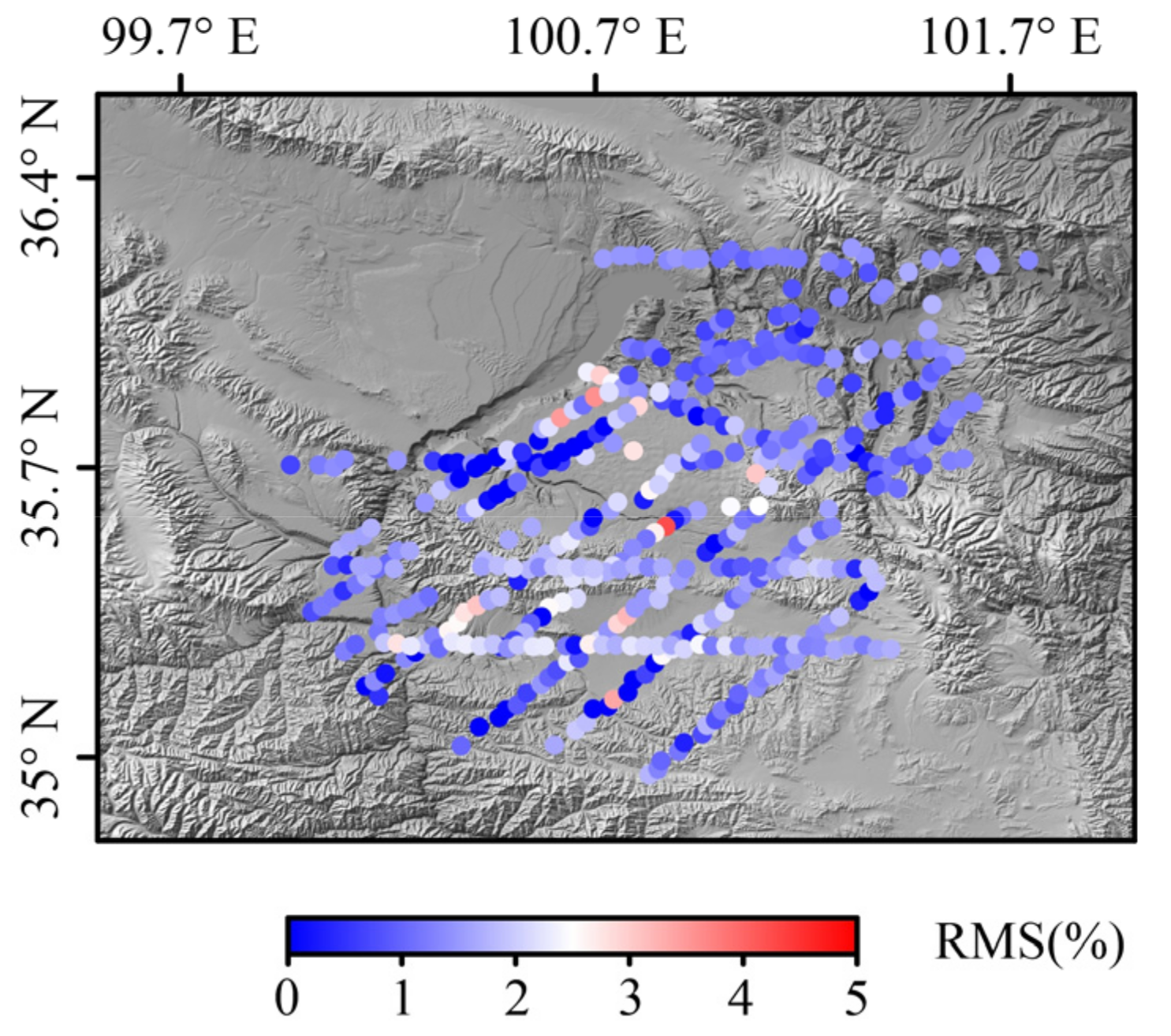
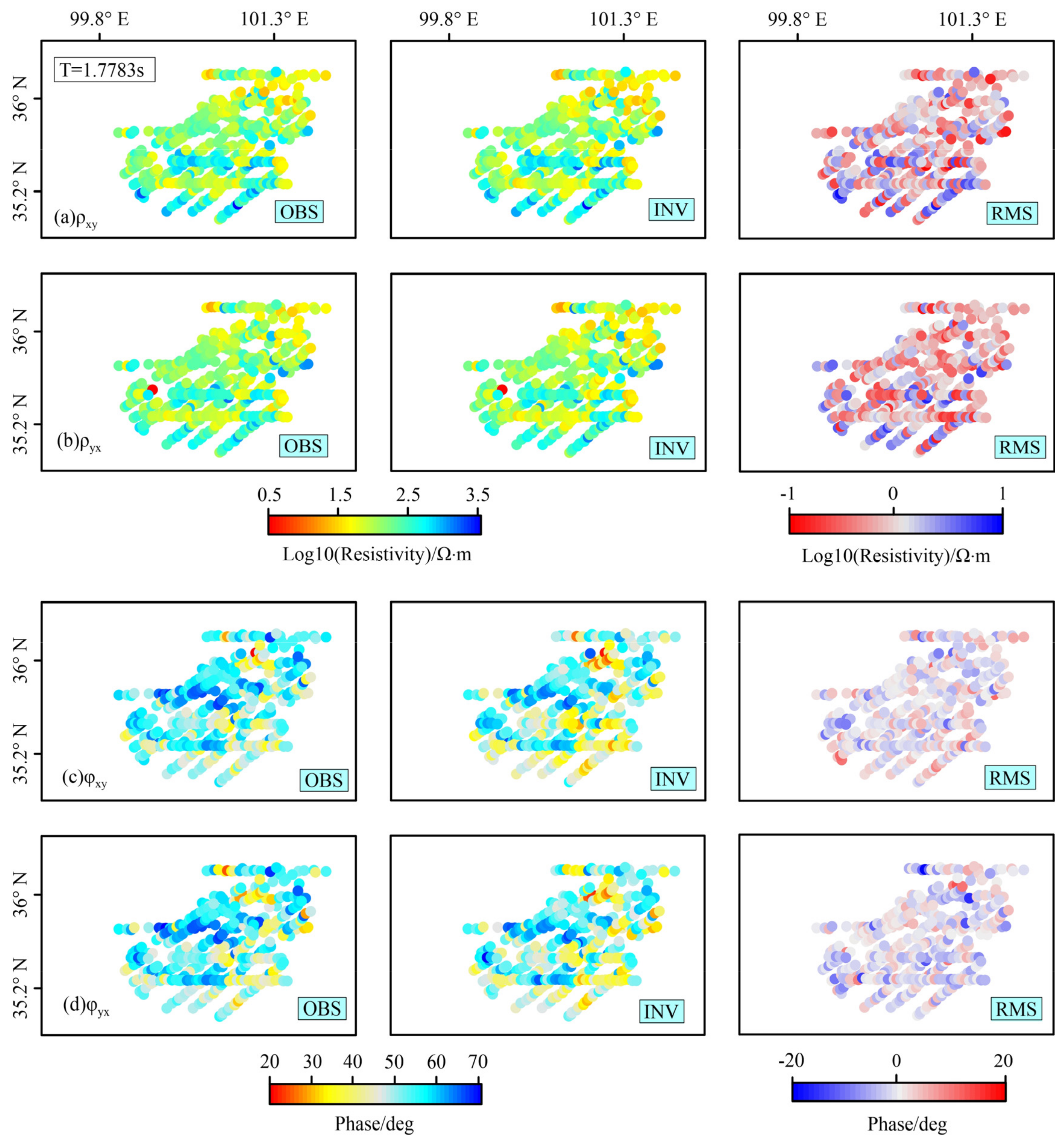
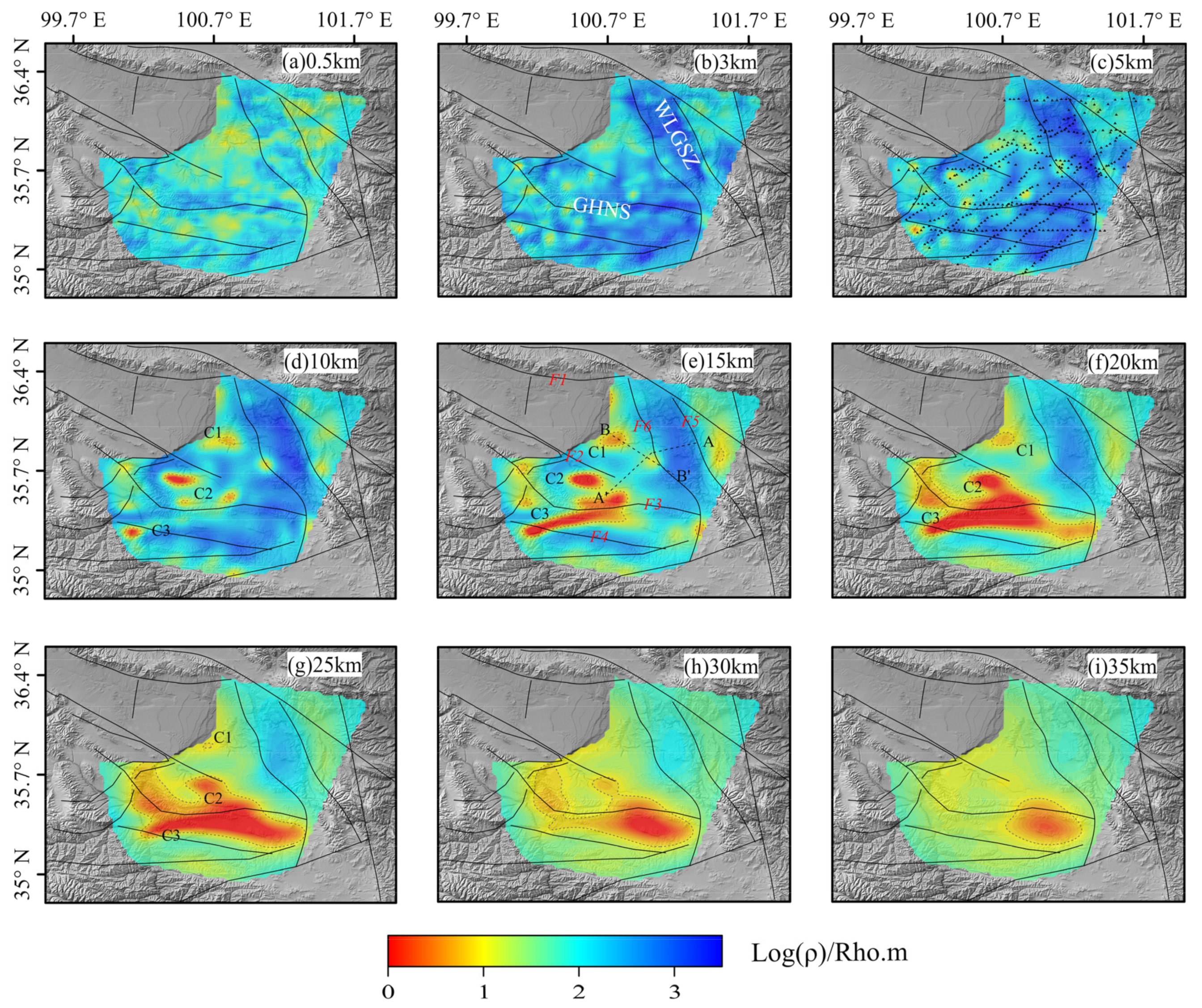


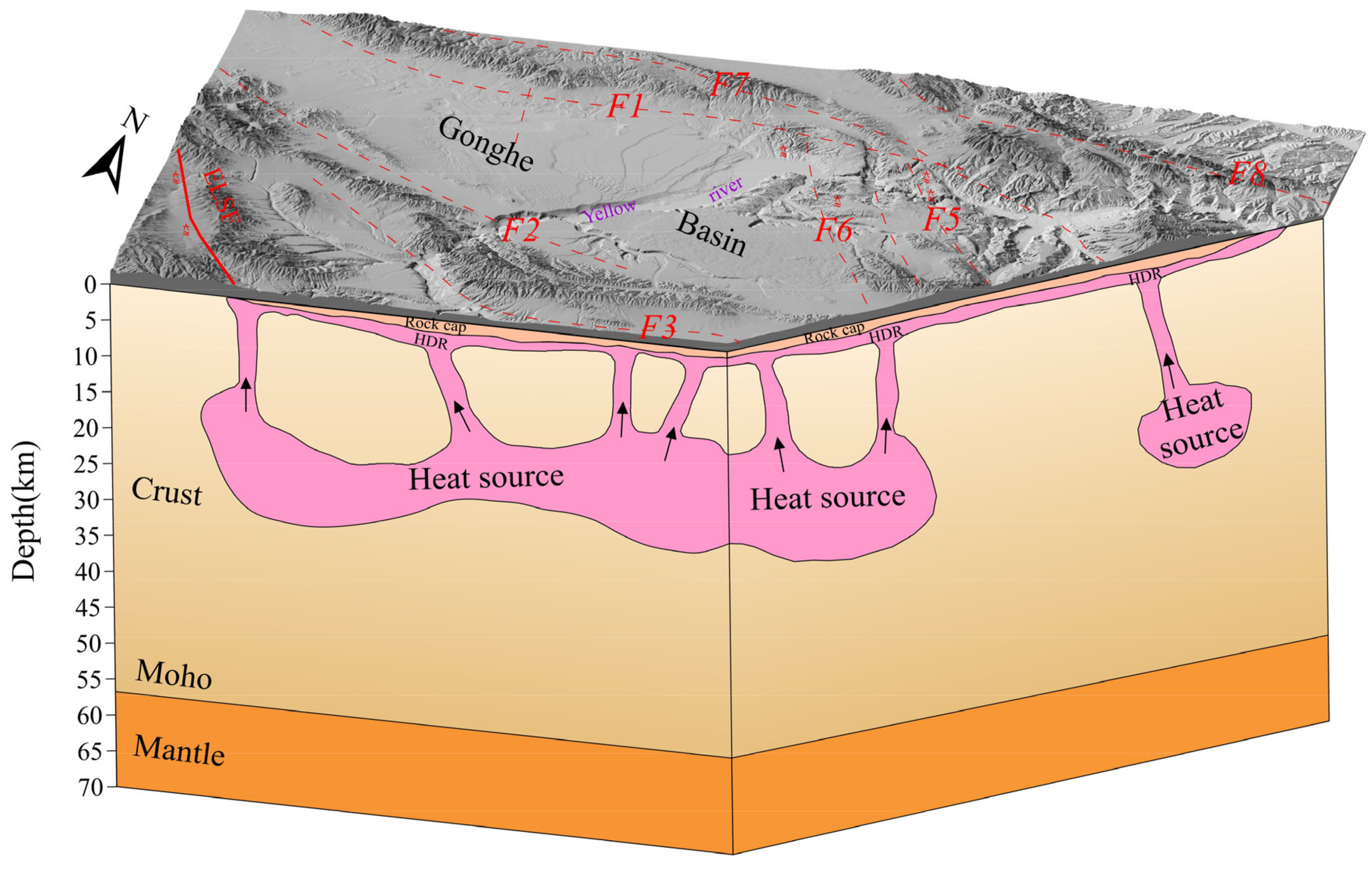
Disclaimer/Publisher’s Note: The statements, opinions and data contained in all publications are solely those of the individual author(s) and contributor(s) and not of MDPI and/or the editor(s). MDPI and/or the editor(s) disclaim responsibility for any injury to people or property resulting from any ideas, methods, instructions or products referred to in the content. |
© 2023 by the authors. Licensee MDPI, Basel, Switzerland. This article is an open access article distributed under the terms and conditions of the Creative Commons Attribution (CC BY) license (https://creativecommons.org/licenses/by/4.0/).
Share and Cite
Yang, Y.; Wang, X.; Liang, M.; Jiang, Z.; Ou, Y.; Tang, X.; Li, X.; Qiu, L.; Liang, M.; Liu, D.; et al. Three-Dimensional Electromagnetic Imaging of Geothermal System in Gonghe Basin. Minerals 2023, 13, 883. https://doi.org/10.3390/min13070883
Yang Y, Wang X, Liang M, Jiang Z, Ou Y, Tang X, Li X, Qiu L, Liang M, Liu D, et al. Three-Dimensional Electromagnetic Imaging of Geothermal System in Gonghe Basin. Minerals. 2023; 13(7):883. https://doi.org/10.3390/min13070883
Chicago/Turabian StyleYang, Yi, Xuben Wang, Mingxing Liang, Zhengzhong Jiang, Yang Ou, Xianchun Tang, Xufeng Li, Liquan Qiu, Meng Liang, Dongming Liu, and et al. 2023. "Three-Dimensional Electromagnetic Imaging of Geothermal System in Gonghe Basin" Minerals 13, no. 7: 883. https://doi.org/10.3390/min13070883
APA StyleYang, Y., Wang, X., Liang, M., Jiang, Z., Ou, Y., Tang, X., Li, X., Qiu, L., Liang, M., Liu, D., & Zhang, J. (2023). Three-Dimensional Electromagnetic Imaging of Geothermal System in Gonghe Basin. Minerals, 13(7), 883. https://doi.org/10.3390/min13070883





